中小民营企业的现状及其发展对策
亚洲开发银行课题
天则经济研究所
茅于轼 张玉仁
1.民营经济的发展历史
A.1978年的改革以前,民营经济几乎等于零。
B.1978—86。随着家庭承包责任制,农村积累了原始资本,民营经济开始得到发展。出现了个体户(雇用不超过八人.。
C.1987—92。开始出现私营企业,雇用人数不受限制。
D.1993— 。民营经济大发展。出台了相关的法律(合伙制、私营企业,独资)
私营(民营.经济包括个体户及私营企业,其产值的变化如下图所示:
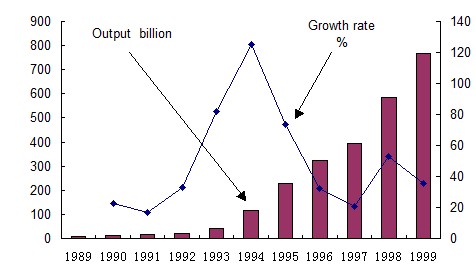
2.民营经济的现状。
各种经济成分就业的变化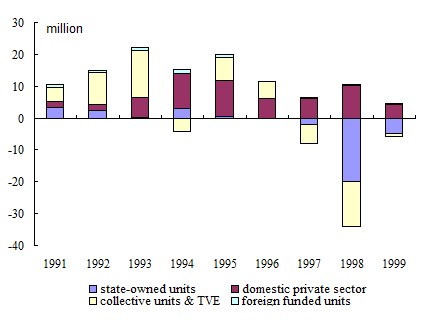
从上图可见,1997年以来国有单位(包括国企及政府.及集体经济共下岗4800万人,只有民营经济能够吸收就业,共吸收了2220万人。
去年初各种经济成分就业的百分比如下图: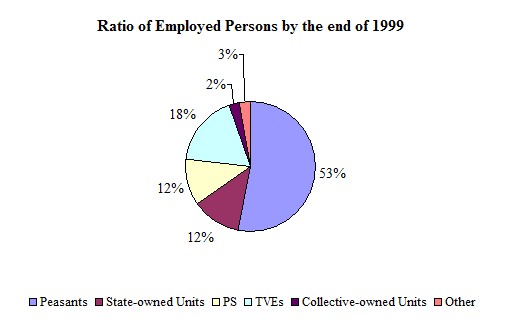
Note: “Other” includes share-holding units, joint-owned units, limited liability corporations, share-holding corporations, ltd., foreign-funded economic units, and economic units funded by entrepreneurs from Hong Kong, Macao, and Taiwan.
从图上可知,除了农民占百分之53之外,集体企业占百分之18,为第二大的就业行业,再其次就是国有单位民营经济,他们各占百分之12.
按照产值来划分,各种经济成分的产值如下:
Table 1.4 Composition of China’s GDP by sector, 1998
| Private Sector a | Domestic Private Company (Excluding Agriculture) b | Private Company (Excluding Agriculture)c | Real Private Company (Excluding Agriculture) d | Private Economy e (Excluding Private agriculture) | Non-state Sector f | ||||||
| State Sector | 38 | State Sector | 38 | State Sector | 38 | State Sector | 38 | State sector | 38 |
State sector |
38 |
| Collective (true) | 12 | Collective (true) | 12 | Collective (true) | 12 | Collective (true) | 12 | Collective (true) | 12 |
Non-state Sector |
62 |
| Agriculture (private) | 17 | Agriculture (private) | 17 | Agriculture (private) | 17 | Agriculture (private) | 17 | Private Economy | 50 |
| |
| Collective (official) | 11 | Collective (official) | 11 | Collective (official) | 11 | Real private Company | 33 |
| |||
| Foreign share | 6 | Foreign share | 6 | Private company | 22 | ||||||
| Share holding | 3 | Domestic Private Company | 16 |
| |||||||
| Domestic Private Sector | 13 | ||||||||||
a.State sector include state-owned agriculture.
b.Domestic private company includes share-holding firms.
c.Foreign share companies were regarded as private company.
d.Real private company include those firms under collective but truly private, assuming they accounted for about half of the official collective firms in some areas and sectors, the proportion of this type in the total collective is more than half.
e.In private economy in including agriculture, state-owned share accounts for about one percent, which has been added to the state sector.
f.Non-state sector consists of true collective and private economy as defined in d.
Source: China’s Emerging PEs, International Finance Corporation (IFC), 2000.
从上图可知,私营经济占产值的百分之13,加上股份公司则为百分之16,再加上外资则为百分之22,再加上假集体则为百分之33,再加上农业则为百分之50,再加上真集体则为百分之62,所以真正的国有为百分之38.
3.民营经济的发展决定了一个省的人均GDP。
民营经济所雇用职工占总就业人口中的比例,决定了一个省的经济发展水平。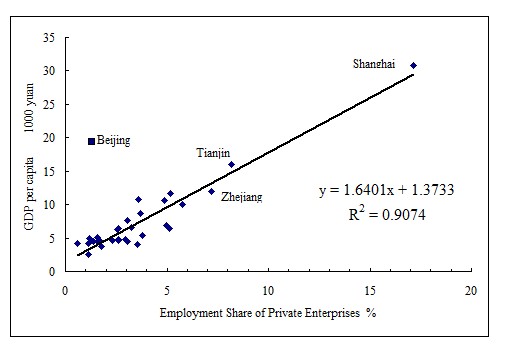
回归证明二者高度相关。富省都有较为发达的民营经济(雇用人数占百分之5.2以上的,人均GDP都超过11000元,但北京除外.,穷省的民营经济无例外地都很不发达(雇用人数低于百分之1.5的省人均GDP都低于5000元.。民营经济雇用人数每增加一个百分点,人均DGP可以增加1640元。这并不是这些民营经济的职工为全省每个人生产了1640元,而是因为民营经济的发展标志着当地经济的活跃程度。
民营经济在各行业的分布如下图所示(按就业,2000年初.: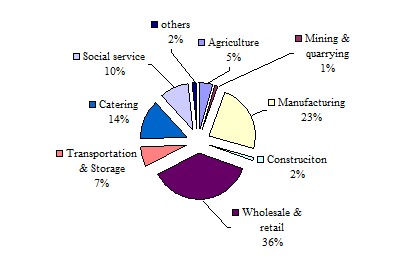
可见民营经济集中在服务业。
私营企业的所有制分布如下:有限责任占百分之54,独资占百分之33,余为合伙制。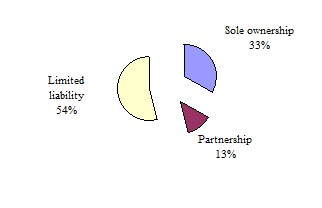
4.民营经济的局限性。
A.家族制的管理;
B.信用记录不良;
C.财务不透明,难于引资,不容易得到大项目。
D.劳资纠纷多。
E.不易吸引高质量的专业人员。
5.发展民营经济的政策建议。
A.与国企应该有平等的竞争条件。从明文规定来看,民营经济的地位已经有很大的改进。现在的主要问题是国企有软约束的优待,在贷款,亏损,司法,集资方面都有政府的支持,形成过度的生产能力和恶性竞争,造成民营企业的额外困难,降低了资源配置的效率。也使得国企改革更为困难,结果是两败俱伤。
B.建立民营银行,专门为民营企业融资。
C.发展中介组织,从外部帮助民营企业改善经营。
D.保护产权,依法治国,改善政府对民营企业的服务,改善投资环境和经营环境。
E.改进民营经济的信用水平,加速资金周转,扩大经营范围,改善经营环境。 版权所有:北京五十人论坛顾问有限公司
版权所有:北京五十人论坛顾问有限公司